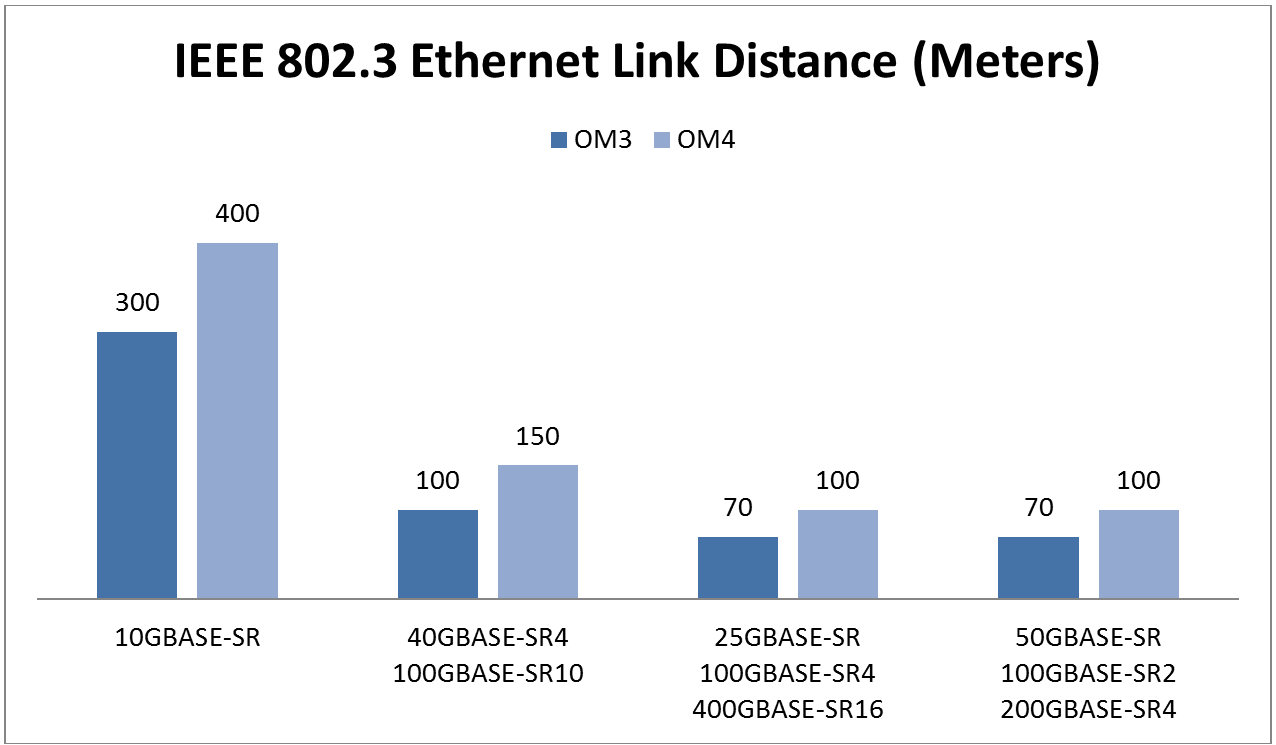The Benefits of High-Quality, Low-Loss Fiber Connectivity
Data centers and LANs are migrating smoothly from 10G to 40G and 100G Ethernet to provide scalability and accommodate more bandwidth as future applications become reality; meanwhile, the imminent deployment requirements of next-generation 200G and 400G Ethernet speeds are already on the horizon, mainly driven by cloud data centers and the wireless 5G ecosystem.
In previous blogs, we’ve explained the differences between singlemode and multimode transceivers, and the differences between “fiber link budget” and “channel insertion loss” as they relate to this migration. When it comes to actual deployment, however, it’s important to note that a high-quality, low-loss fiber solution makes all the difference when it comes to reducing risk, avoiding performance problems and minimizing total cost of ownership.
Shrinking Reach and Power Budget in Multimode Fiber Systems
Multimode fiber (MMF) is a cost-effective solution for short-reach optical interconnects of up to a few hundred meters. Less expensive than singlemode fiber (SMF), it’s often used for server-to-server or server-to-network switch connections.
Parallel optics – using four 10G channels to simultaneously transmit and receive data over multiple fibers – are a viable way to support high-bit-rate Ethernet speeds; however, the migration from 10G to 40G Ethernet (4× 10G) has been achieved at the cost of reduced reach, from 300m/400m in OM3/OM4 to 100m/150m in OM3/OM4.
As bit rates increase from 10 Gbps to 25 Gbps, actual link distance has shrunk again to 70m/100m in OM3/OM4 for 100GBASE-SR4 (4× 25G).

Figure 1: IEEE 802.3 Ethernet link distances for different speeds
As MMF reach shrinks when migrating to higher speeds, so do power budgets and insertion loss budgets. Using OM4, total fiber cable and connection loss budget is 2.9 dB at 10G; it has dropped to 1.9 dB at 25G/40G/100G.

Figure 2: IEEE 802.3 Ethernet MMF fiber link budget * in progress
Looking beyond 100G, IEEE 802.3cd, a taskforce focusing on 50G-per-lane technologies, has decided to keep supporting 100m as the maximum reach in OM4 (50GBASE-SR/100GBASE-SR2/200GBASE-SR4). In this new implementation, PAM4 modulation format (where four distinct pulse amplitudes are used to convey information) has been adopted to reduce required component bandwidth by a factor of two. This decision maintains the appeal of MMF, but decreases power budget headroom – mainly due to reduced optical signal-to-noise ratio (OSNR).
Benefits of Low-Loss Fiber Connectivity
The IEEE 802.3 Ethernet link specification states that each fiber connection/splicing loss should not exceed 0.75 dB; the total loss of fiber connection/splicing should not exceed 1.5 dB. This minimum requirement, however, cannot satisfy data center structured fiber cabling deployment; quite often, more than five connection points are needed. In many applications, premium-quality transceivers and premium glass fiber are required to build engineered links with extra link distances. (An engineered link is any solution that reaches farther or enables more system margin to support additional connector pairs in the link than what standards describe).
Released as an ISO/IEC standard in October 2016, new OM5 MMF cabling has provided a new solution with enhanced wavelength coverage. TIA has recently also tightened its fiber cable attenuation minimum specification from 3.5 dB/km to 3.0 dB/km in the new TIA 568.3-D standard: Optical Fiber Cabling and Components Standard.
This change allocates more link headroom and reliability to MMF links. As shown in Table 1 below, with improved bandwidth, a low-loss fiber connectivity solution not only extends link reach but also supports more connection points.
For example, a legacy OM3 cable assembly with ~0.5 dB per connection loss can only support a three-point connection with a maximum reach of 100m for a 40GBASE-SR4 transceiver, or a three-point connection with a maximum reach of 70m for a 100GBASE-SR4 transceiver.
In comparison, a high-quality OM4/OM5 duplex pair or MPO-12 assembly with <0.2 dB-per-connection loss will allow a six-point connection of 150m reach for 40GBASE-SR4, or up to an eight-point connection of 100m reach for a 100GBASE-SR4 transceiver with sufficient link margin.
Another benefit of using low-loss fiber connectivity is that it supports more link headroom when building engineered links. In some deployment cases, extended reach is required above the nominal reach limit (e.g. 180m OM4 reach using 40GBASE-SR4 transceiver; nominal maximum reach is 150nm in OM4). More power budget can be allocated for the extra fiber distance because the consumed link loss on connection/splicing is lower than the allocated budget.

Table 1: Ethernet link comparison between legacy OM3 and low-loss OM4/OM5 solutions
Make a Wise Decision About Fiber Connectivity
Rock-solid performance and huge cost savings can be achieved with a futureproof cabling system that can live through a few upgrade cycles.
For example, low-loss OM4/OM5 connectivity supports a smooth, hassle-free migration path from 10G to 400G. Only the active gear and optical transceivers need to be replaced when more bandwidth is needed; cable infrastructure will be intact and reusable for a long time.
Since 2015, SMF has been adopted in cloud data centers with very large footprints. In these many-football-fields-size data centers, only an SMF solution can meet reach and bandwidth requirements.
To support this new ecosystem, a few new singlemode transceiver variants have been designed to support data center reach (500m and 2km). These new transceivers are designed with customized optics and tight power budgets compared to traditional 10km long-reach transceivers.
As millions of these transceivers are installed in hyperscale data centers, fiber infrastructure performance and reusability to support a number of upgrade cycles is even more critical to maximize return on investment.
Whether you are planning to install new MMF cabling or SMF cabling, it’s important to find a truthful data center infrastructure partner that can provide the best, most sustainable, highest-quality and most cos-effective solution as you build your futureproof fiber infrastructure. Learn more about Belden’s fiber solutions, which are faster, easier and better to use.
